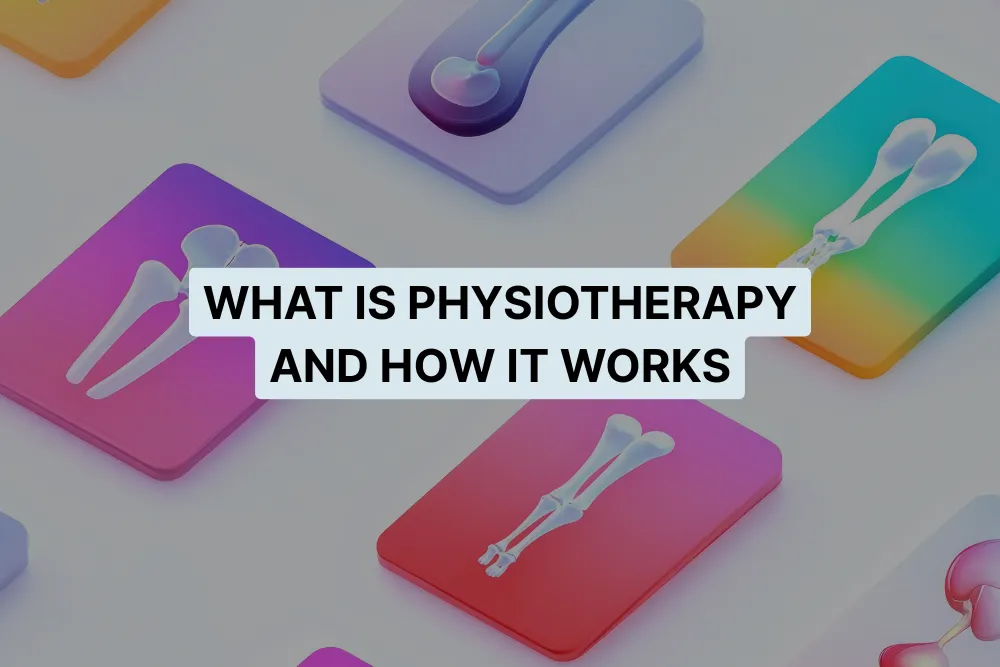If you’ve ever had back pain, you’re definitely not alone – 8 out of 10 people deal with it at some point. For many, the solution isn’t surgery or lifelong medication – it’s physiotherapy. But what exactly is physiotherapy, and how does it work?
Physiotherapy is far more than a set of exercises or massages. It is a science-backed healthcare profession that helps people restore movement, manage pain, and recover from injury or illness. At Physioveda, we often explain physiotherapy as the art and science of helping the body heal itself, without invasive procedures or unnecessary dependence on medication.
What is Physiotherapy?
Physiotherapy (also called physical therapy) is a branch of healthcare that focuses on assessing, diagnosing, and treating physical problems caused by injury, illness, disability, or aging.
Physiotherapy plays a central role in rehabilitation and is key to helping people achieve and maintain functional independence. Ever wondered why so many athletes bounce back quickly after injuries? Or how older adults stay independent even with arthritis? That’s the power of physiotherapy.
Unlike quick fixes, physiotherapy focuses on long-term health, recovery, and prevention.
The Science Behind Physiotherapy
To understand how physiotherapy works, it’s good to know how our body works. Think of your body like a machine, if one part is jammed, the whole system slows down. Physiotherapy works like the mechanic, helping every part move smoothly again
It combines anatomy, biomechanics, and neuroscience to help patients recover naturally. Many of our patients are surprised when simple posture changes or targeted stretches relieve years of pain. It’s often the small adjustments, guided correctly, that make the biggest difference.
Common Conditions Treated with Physiotherapy
Physiotherapy helps across a wide range of conditions such as:
- Musculoskeletal issues: Back pain, neck stiffness, arthritis, frozen shoulder, joint injuries.
- Sports injuries: Muscle strains, ligament sprains, tendon problems, ACL tears.
- Neurological conditions: Stroke rehabilitation, Parkinson’s disease, cerebral palsy, multiple sclerosis.
- Post-surgical recovery: Joint replacement, spinal surgeries, ligament reconstructions.
- Elderly care: Mobility support, fall prevention, balance training.
- Respiratory & cardiac conditions: Chest physiotherapy, post-COVID rehabilitation, cardiac rehab.
Who Can Benefit from Physiotherapy
Physiotherapy is suitable for all ages and activity levels:
- Children benefit from developmental or postural concerns.
- Adults seek care for sports injuries, workplace strain, or post-surgical recovery.
- Elderly patients use it to maintain mobility, balance, and independence.
It is effective for both acute conditions (recent injuries or surgeries) and chronic issues (arthritis, long-term back pain, neurological disorders).
How Physiotherapy Works in Practice
No two patients are the same, and neither are their treatment journeys. Here’s what typically happens when you visit a physiotherapist:
Initial Assessment
The first step in any physiotherapy journey is a detailed assessment, which involves taking a thorough history of the patient’s symptoms, lifestyle, and medical background. This is followed by a physical examination that looks closely at posture, strength, flexibility, and movement patterns to identify the root cause of the problem.
Diagnosis & Goal Setting
Once the assessment is complete, the physiotherapist focuses on identifying the root cause of the problem rather than just addressing the symptoms. Together with the patient, realistic recovery goals are then set.
Personalized Treatment Plan
Physiotherapy is never a “one-size-fits-all” approach. Each treatment plan is tailored to the individual and may include a combination of methods such as manual therapy, exercise therapy, electrotherapy, dry needling, taping, and patient education.
Progress Monitoring
As treatment progresses, the plan is continuously adjusted based on the patient’s recovery speed and feedback. At the same time, emphasis is placed on strengthening and preventive strategies to ensure long-term results and reduce the risk of recurrence.
How Long Does It Take?
Recovery timelines vary. Some people notice improvements within 3-4 sessions, while chronic or neurological conditions may need several weeks of steady care. Your physiotherapist will guide you on how often to come in and give you exercises to continue at home, so progress doesn’t stop between visits.
Techniques Employed in Physiotherapy
Physiotherapists use a wide range of evidence-based techniques depending on the condition, age, and goals of the patient. The most common approaches include:
- Manual Therapy
- Exercise Therapy
- Electrotherapy & Modalities
- Dry Needling & Acupuncture Techniques
- Kinesiology Taping & Bracing
- Hydrotherapy (Aquatic Therapy)
- Postural Correction & Ergonomics Training
- Education & Lifestyle Coaching
Safety and Limitations
Physiotherapy is generally safe for most people, but it should always be performed under the guidance of a qualified physiotherapist. Certain conditions may require modifications or careful monitoring. Patients are encouraged to communicate openly with their physiotherapist about any discomfort or medical concerns to ensure safe and effective treatment.
Conclusion
Physiotherapy is not just about exercises, it’s about restoring health, preventing future problems, and empowering people to live actively and independently. At Physioveda, we believe movement is medicine, and with the right guidance, your body has the power to heal itself.
👉 If you’re struggling with pain, recovering from surgery, or want to explore physiotherapy for better health, book a consultation with Physioveda today and take the first step towards recovery.

Amit Saraswat is the Founder of Physioveda Medical Center, a Dubai-based clinic focused on personalized physiotherapy and integrative healthcare. With a passion for patient-centric solutions, he leads the vision behind Physioveda’s evidence-based approach to pain relief and long-term recovery.

